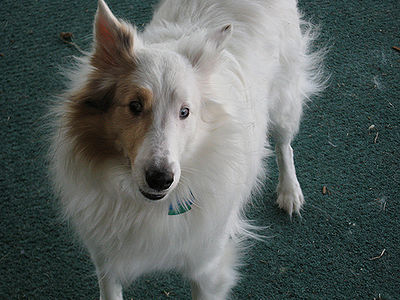
Living with a deaf dog brings additional challenges. It’s a good idea for all of us to study the needs of a deaf dog.
While some dogs are born deaf, old age, injury or illness can bring on deafness. Breeds that have a high propensity for hereditary deafness include the Australian Cattle Dog, Australian Shepherd, Bull Terrier, Catahoula Leopard Dog, Dalmatian, English Cocker Spaniel, and English Setter. However deafness can occur in any breed.
There are a number of reasons why a dog may be deaf – illness, disease, chronic ear infections, the aging process and as mentioned earlier, deafness can be hereditary. Your dog should be seen by the vet if you suspect a problem in order to discover the cause.
How can you tell if your puppy or dog is deaf or just ignoring you?
When your dog is sleeping, he won’t respond to loud noises. You can test for deafness by running the vacuum cleaner or banging pots behind him. Also clapping your hands, playing with a toy that makes noise, all out of his vision. If he cannot see you he won’t respond to the sound of your voice. He won’t hear a knock on the door or the ring of a doorbell.
It is difficult to tell with home tests whether a dog is partially or wholly deaf. Dogs adjust to hearing loss, but are more sensitive to movement and vibrations which can be airborne as well as felt through the floor. They are sensitive to light and changes in air pressure.
The most reliable way to test your dog for deafness is called the BAER test – Brainstem Auditory Evoked Response. This test can be costly, but it is accurate and can let you know if your dog is partially or wholly deaf. It is painless, using inserts in the ear attached to computers which record brain activity in response to sound. The BAER test can be performed as early as 6 weeks of age.
Living with a deaf dog means you must learn a new method of training. Deaf dogs are not dumb, they just have to learn to use their other senses to respond to you and their surroundings.
To begin with it’s important for your dog to focus his attention solely on you. During the first part of training try to have as few distractions as possible. As your dog progresses, you can gradually add distractions. Use hand signals (you can make up your own or use ones for hearing dogs) and at the same time, the proper word for the command so that your dog is familiar with your facial expressions and body language. All of this will help your dog to associate commands with signals. Make sure hand signals are visible even at a distance. Be consistent, using the same signals for the same commands all the time so as not to confuse your dog. When your dog does something correctly, show him how pleased you are, give a treat and a pet.
To get your dog’s attention you can use touch, near or on the head. Practice “watch me” by holding a treat, gradually moving it up to your face as your dog looks at you. Treat as soon as your dog makes eye contact. Once your dog understands the watch me command, you can teach stay by holding your fingers up, palm towards your dog. For sit, hold a treat near the dog’s nose gradually moving it over the head, forcing the dog to sit. Each time your dog responds, give a treat.
You’ll need something special to train your dog to come. There is a vibrating collar available that can be used to signal him. The light of a flashlight works well too. Use a reward he especially likes when training this command. A method that works well is taking small steps backward and when your dog follows, treat and praise. You can wave your hands toward you and when your dog responds and comes to you, give him/her a treat.
Your dog has an incredible sense of smell. You can teach him to find his way home by using objects placed randomly that have your scent on them. Of course, never, ever, leave your deaf dog outdoors alone. Hearing-impaired dogs should always be leashed outdoors in unsecured areas.
Whenever your dog does something well, you want to encourage him by making up a sign for yes, at the same time using the word and giving a treat.
My dogs are not hearing-impaired at present, but as part of their training, I’ve taught them to respond to hand signals. It’s a good idea to incorporate hand signals into regular training to be prepared for anything that can happen.
With time and patience, your reward will be a loyal friend who at most times, you won’t even notice that he’s a bit challenged.



